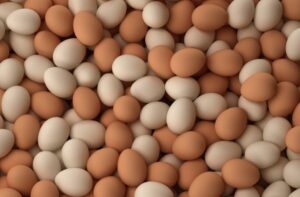Export of goods in Jan-Feb 2023 on most important positions and in relation to Jan-Feb 2022

Source: Open4Business.com.ua and experts.news

Electricity exports, which resumed in April after being halted in October, totaled 89,700 MWh for the month, according to data on the website of the ENTSO-E network of continental European system operators.
Most of the electric power was exported to Moldova – over 40 thousand MWh, another 30.4 thousand MWh was supplied to Poland and 19.2 thousand MWh – to Slovakia.
For Moldova, traders have been gradually increasing their booked cross-section capacity for exports and in recent days have booked about 85-95% of the 650 MW of offered hourly capacity. The market claims that most of the electricity supplied to Moldova goes on to Romania.
On the whole, the biggest volumes were reserved by “ECU” (150 MW per hour), PrJSC “Ukrhydroenergo” (100 MW per hour), “D. Trading” (130 MW per hour), “Artlex Energy” and “Sipige Energy” (mostly 50 MW per hour). DE Trading, ERU Trading, EES, Kub Energy, Smart Grid Ukraine, NAP-Comunity, NAP-Comunity Trading, and Astat Energy also booked the section. Besides, on April 26, Centrenergo PJSC started exporting electricity, having booked 10-11 MW per hour.
DTEK Zakhidenergo exports electricity to Poland, traditionally at 1800 MWh per day, reserving for this purpose the maximum at this time of the cross section capacity – 75 MW per hour.
The section to Slovakia, the only one paid by traders because of the great interest and competition in this direction, was shared by DTEK Zakhidenergo, which bought up to 146 MW of its 200 MW hourly capacity, DE Trading (about 50 MW), ERU Trading, Le Trading Ukraine, TES and once state energy trader EKU, which bought 10 MW for one hour.

European Commission Executive Vice President Valdis Dombrovskis says the European Commission has reached agreements in principle with Bulgaria, Hungary, Poland, Romania and Slovakia on the export of Ukrainian agricultural products.
“There are agreements,” he wrote in capital letters on his Twitter page Friday.
Dombrovskis said the European Commission reached “an agreement in principle with Bulgaria, Hungary, Poland, Romania and Slovakia regarding Ukrainian agri-food products.” “Together with Janusz Wojciechowski (European Commissioner for Agriculture) we have taken measures to solve the problems of both farmers in neighboring EU countries and in Ukraine,” he wrote.
The Vice President also named the key elements of the deal, which were also agreed with Ukraine. These elements include the removal of unilateral measures by Poland, Slovakia, Bulgaria and Hungary. Then there are “exceptional safeguard measures for 4 products: wheat, corn, rapeseed, sunflower seeds and a support package of 100 million euros for affected farmers in 5 member states.
In addition, Dombrovskis reported on the investigation of some other products, including sunflower oil.

The volume of IT services exports from Ukraine in the first quarter of 2023 decreased by 16 percent year-on-year to $1.68 billion, the IT Ukraine Association said in a press release on Friday.
It pointed out that for January-December 2022, IT services exports increased by $400 million compared to 2021, to $7.35 billion.
“This decline (in Q1-2023) is due to two factors: first – in previous years, the industry grew at an ultra-high rate, and second – each first quarter of a new year traditionally has a decline compared to the first quarter of the previous year. However, the results of the quarterly exports of IT-services from Ukraine in 2022-2023 show that now the industry has entered into a “flat”, that is, growth has stopped and a significant decline has not begun, “- a comment from the executive director of the Association IT Ukraine Konstantin Vasyuk said in a press release.
According to the Association, in the fourth quarter of 2021, exports of IT services from Ukraine amounted to $ 2.11 billion, in the first quarter of 2022 – $ 2 billion, in the second quarter – $ 1.74 billion, in the third quarter – $ 1.74 billion, in the fourth quarter – $ 1.87 billion. At the same time, the first quarter 2023 export figure is higher than any first quarter figure since 2014, when it was only $0.34 billion. Even in Q1 2021, the figure was lower than the current $1.44 billion. It was only surpassed in Q1 2022 at $2 billion.
It is reported that according to the Association’s observations, which are based on data from the National Bank (NBU), a similar situation took place in 2014, when the IT-sector also showed a drop of 26% and held positions $350-400 million quarterly. However, in 2016, the IT-sector resumed growth and until 2022 was adding 20% annually.
With reference to the NBU data, the IT Ukraine Association reports that IT services account for 43% of total services exports from Ukraine in the first quarter of 2023.

Ovostar Union Agro Group, one of Ukraine’s leading egg and egg products producers, cut egg production by 2% to 362 million eggs in the first quarter of 2023, but was able to significantly boost exports of products with a significant increase in prices compared to last year, according to an operational report on the Warsaw Stock Exchange on Thursday.
“Management has taken all steps to minimize the adverse effects on the current production situation, which made it possible to maintain production and sales at the prewar level,” Boris Belikov, the company’s CEO, said in the report.
According to him, the range of products and distribution channels have been reviewed and brought in line with current market needs, and in general, taking into account the circumstances, the results of the group in the first quarter of 2023 can be considered satisfactory.
It is pointed out that the number of laying hens decreased by 2% in the first quarter of 2023 compared to one year ago, including a 6.2% decrease to 7.12 million and 6.38 million laying hens, respectively.
Sales in the egg segment rose 4% to 241 million, including export sales jumped 3.9 times to 105 million, and their share rose from 11% to 44%.
The average price of eggs rose 56% to $0.139/egg during the reporting period, according to the report.
According to the report, the volume of processed eggs in Q1 2023 remained at the level of the previous year – 92 million eggs: 406 tons of dry and 3,073 thousand tons of liquid egg products were produced, compared to respectively 561 tons and 2,131 tons in the first quarter of last year.
Sales of dry egg products increased to 531 tons from 429 tons in the first quarter of 2022. Exports increased to 354 tons, or 67%, from 238 tons, or 55%.
Sales of liquid egg products rose to 3,063,000 tons from 2,182,000 tons, including exports of 1,291,000 tons versus 728 tons, increasing its share to 42% from 33%.
As with eggs, the average price of egg products for the year increased significantly: dry – by 32%, to $ 8.79 / kg, liquid – by 44%, to $ 2.66 / kg (all prices are excluding VAT).
Taking into account these sales figures and prices, the total revenues of the three product categories in the first quarter of this year can be estimated at $46.3 million, up 68.1% as compared to $27.6 million in the first quarter of last year.
The group’s holding company, Ovostar Union N.V. – in mid-June 2011, it floated 25% of its shares on the WSE and raised $33.2 mln. Its majority stake is owned by Prime One Capital Limited, which is controlled by its chief executive B. Belikov and chairman of the board Vitaliy Veresenko.
In 2022, Ovostar reportedly reduced egg production by 9% to 1.55 billion eggs and sales by 6% to 1.08 billion eggs.
Sales of dry egg products over the past year decreased by one-third to 2.13 thousand tons, liquid – by 26%, to 10.62 thousand tons.

Ukraine in January-March this year, Ukraine increased exports of sunflower oil by 14.5% – to 1 million 322.611 thousand tons.
According to customs statistics, in monetary terms, exports of these products in the first quarter decreased by 13.6% – to $1 billion 355.889 million ($1 billion 568.449 million in the first quarter of 2022).
In 2022, Ukraine reduced exports of sunflower oil by 16.4%, to $4 billion 290.336 million, in monetary terms – by 14.5%, to $5 billion 464.151 million.